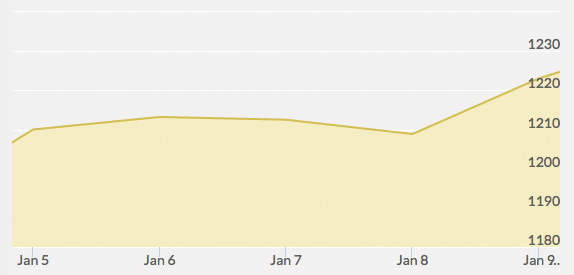
Open: $1,200.80 Close: $1,220.80 | High: $1,200.80 Low: $1,220.80
Monday opened at right around the key $1,200 mark, gaining 1% since last week. The yellow metal’s strong opening was primarily due to turmoil in Greece, a falling euro, lower crude oil and increased buying in China in anticipation of the Lunar New Year in February. Gold was the highest against the euro since September 2013.
Concerns in Greece about the upcoming elections on January 25 caused the euro to lose value this week, which was bullish for gold. Many fear that Greece will leave the Eurozone. If this happens, gold will be more attractive as a safe haven fund.
Tuesday saw gold hit a three-week peak, maintaining momentum from the beginning of the week. Oil prices continued to decline, and the S&P 500 fell below 2,000 for the first time since Dec. 17th against rising U.S. bond prices. The dollar also slid on these combined factors. The gold market, therefore, enjoyed a return to safety funds.
Gold lost some of its gains by Wednesday, as the dollar rose slightly and the Federal Reserve announced no change in interest rates. The U.S. economy has consistently showed signs of positive recovery. FOMC minutes did not show any future action points, however, and were labeled a “non-event” by BMO Capital markets director Tai Wong. Yet, the yellow metal was less attractive mid-week as oil prices plunged lower.
Thursday continued the losing streak on a heightened dollar and a delayed reaction to the FOMC minutes. The announcement that U.S. interest rates would not be rising influenced a surge in European stocks, which was bearish for gold because it reduced safe haven trading.
Despite the ups and downs, gold ended the week up 2.5%, pulling out of its three-week losing streak. U.S. payroll data was released on Friday, and unemployment rates showed improvement, yet equities did not react. This spurred gold higher to end the week around $1,220.


